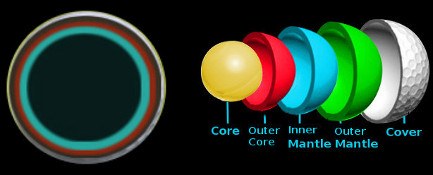Golf ball compression refers to the degree of deformation the ball undergoes when it is struck by the clubface during a golf shot. It is a measure of the ball's ability to compress and then quickly regain its shape upon impact.
Here are some key points about golf ball compression: 
- Compression Rating: Golf balls are assigned a compression rating, typically ranging from around 40 to 100 or more. The compression rating is a numerical value that indicates the relative firmness or softness of the ball's core.
- Low Compression: Golf balls with a low compression rating, typically below 70, are considered soft. They compress more easily upon impact with the clubface, allowing slower swing speed players to achieve greater ball compression and maximize distance. Low compression balls often provide a softer feel and enhanced control on shorter shots.
- High Compression: Golf balls with a high compression rating, typically above 90, are considered firm. They require a higher swing speed to compress fully. Higher compression balls are often preferred by players with faster swing speeds, as they tend to offer more distance and control.
- Swing Speed Considerations: The choice of golf ball compression often depends on the golfer's swing speed. Slower swing speed players may benefit from using a low compression ball to optimize distance and feel, while higher swing speed players may benefit from a higher compression ball to achieve better energy transfer and maintain control.
- Construction Factors: Golf ball compression is influenced by various factors, including the core material, cover material, and overall construction of the ball. Different ball models and brands may have varying compression characteristics within their respective compression ranges.
- Personal Preference: Golfers may have individual preferences for ball compression based on their feel, shot trajectory, and performance expectations. It is essential for golfers to experiment with different compression ratings and ball models to find the one that suits their swing characteristics and playing style.
It's worth noting that while golf ball compression can impact performance, it is not the sole determining factor. Other factors such as spin, cover design, and dimple pattern also play important roles in the overall performance of a golf ball.
Update:
Golf ball compression refers to the level of hardness or softness of a golf ball. It is measured in a numerical value, usually ranging from 0 to 200. Low compression balls are softer and deform more upon impact, while high compression balls are harder and deform less. Choosing the right compression for your game can significantly impact your distance, control, and feel.
Q&A:
- Q: What is the significance of golf ball compression for different swing speeds? A: Golfers with slower swing speeds typically benefit from using low compression balls, as they generate more distance and spin with softer balls.
- Q: Do high compression balls suit players with faster swing speeds? A: Yes, golfers with higher swing speeds can benefit from high compression balls, as they compress less and produce a firmer feel and reduced spin.
- Q: Can golf ball compression affect ball flight? A: Yes, compression influences ball flight. Low compression balls tend to fly higher and have more spin, while high compression balls may produce lower trajectories.
- Q: How do I determine the best compression for my game? A: Experiment with different compression balls to find the one that offers the right combination of distance, control, and feel for your swing.
- Q: Are there compression options for golfers with moderate swing speeds? A: Yes, golf ball manufacturers offer a range of compression options to suit various swing speeds and player preferences.
- Q: Can I use high compression balls to improve my distance? A: Using high compression balls with a slower swing speed may lead to reduced distance, as these balls require higher impact speeds to compress fully.
- Q: Are compression ratings standardized across all brands? A: While compression values are used by manufacturers to describe ball hardness, the exact measurement methods may vary, making direct comparisons challenging.
- Q: Can ball compression affect short game performance? A: Yes, ball compression can influence feel and spin around the greens, affecting chip shots and putting.
- Q: What are the benefits of using low compression balls in colder weather? A: Low compression balls tend to compress more in colder temperatures, providing golfers with better distance and feel in chilly conditions.
- Q: Is there a significant difference in feel between low and high compression balls? A: Yes, low compression balls feel softer off the clubface, while high compression balls offer a firmer sensation.
- Q: Can I mix ball compression types in my bag? A: Some golfers opt to use different compression balls for specific shots, such as using a softer ball around the greens and a firmer ball for long shots.
- Q: Are there any drawbacks to using high compression balls? A: High compression balls may feel harsher on mishits, and golfers with slower swing speeds might not fully compress the ball, leading to reduced distance.
- Q: How can I find the right compression for my game without trying multiple balls? A: Consult with a golf professional or visit a launch monitor to determine your swing speed and get recommendations for the appropriate compression.
- Q: Can I switch ball compressions based on weather or course conditions? A: Yes, some golfers adjust their ball compression based on the playing conditions to optimize performance.
- Q: Are there differences in compression between tour-level balls and recreational balls? A: Tour-level balls typically have higher compression and are designed for advanced players seeking precise control and feel, while recreational balls often have lower compression for ease of use and distance for average golfers.
Choosing the right golf ball compression is essential for optimizing your performance on the course. Experiment with different options and consider factors like swing speed, feel, and weather conditions to find the ideal compression for your game.





